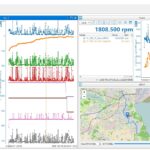The OBDII code P0556 indicates a problem with the brake booster pressure sensor circuit. This sensor plays a crucial role in monitoring the brake booster’s performance and ensuring sufficient braking assistance. This article will delve into the details of the P0556 code, outlining its causes, symptoms, diagnostic procedures, and common misdiagnoses.
Decoding the P0556 Code
The Powertrain Control Module (PCM) constantly monitors the voltage signal from the brake booster pressure sensor. This signal reflects the pressure within the booster, indicating the level of braking assistance available. When the PCM detects a voltage signal that doesn’t correspond to the expected pressure, especially during braking, it triggers the P0556 code. This signifies a fault within the brake booster pressure sensor circuit.
Recognizing the Symptoms of P0556
While the illumination of the check engine light is a clear indicator, other symptoms might accompany the P0556 code:
- Hard Brake Pedal: Increased effort required to depress the brake pedal, making braking more challenging.
- Reduced Braking Assistance: A noticeable decrease in the effectiveness of the power brakes, requiring more force to stop.
- Illuminated Service Engine Soon Lamp: The check engine light will illuminate to alert the driver of a potential issue. In some cases, multiple drive cycles with the fault might be necessary for the light to come on.
Common Causes of P0556
Several factors can contribute to the P0556 code:
- Vacuum Leaks: Leaks in the vacuum system leading to the brake booster can disrupt pressure readings, triggering the code.
- Faulty Brake Booster Pressure Sensor: A malfunctioning sensor can provide inaccurate readings to the PCM.
- Electrical Issues: Damaged wiring, corroded connectors, or shorts in the sensor circuit can disrupt signal transmission.
- Defective One-Way Valve: A faulty one-way valve in the vacuum supply hose can prevent proper vacuum build-up.
- Cracked Vacuum Hoses: Damaged hoses can lead to vacuum leaks and pressure inconsistencies.
Avoiding Misdiagnosis of P0556
While a failing brake booster can cause the P0556 code, it’s crucial to rule out other more common culprits first. Vacuum leaks, sensor faults, and electrical issues are often mistakenly diagnosed as complete booster failures, leading to unnecessary replacements. Thorough diagnostics are essential.
Diagnosing the P0556 Code
A systematic approach is crucial for accurate diagnosis:
- Visual Inspection: Begin by thoroughly inspecting all wiring, connectors, and vacuum hoses for damage, corrosion, or leaks.
- Code Retrieval: Use an OBDII scanner to retrieve stored codes and freeze frame data. This information provides valuable context for the fault.
- Sensor Resistance Test: Disconnect the brake booster pressure sensor and measure its resistance using a digital multimeter. Compare the reading to manufacturer specifications.
- Voltage and Ground Test: Check for proper voltage and ground signals at the sensor connector.
- Circuit Continuity Test: If voltage and ground are absent, disconnect the PCM connector and test for continuity throughout the circuit to identify any open or shorted wires.
Conclusion: Addressing the P0556 Code
The P0556 code signals a problem within the brake booster pressure sensor circuit. By understanding its potential causes and utilizing a systematic diagnostic approach, you can effectively pinpoint the root cause and implement the necessary repairs. Remember, accurate diagnosis is key to avoiding unnecessary part replacements and ensuring a safe and reliable braking system. If you are unsure about performing these diagnostic steps, consult a qualified automotive technician.

